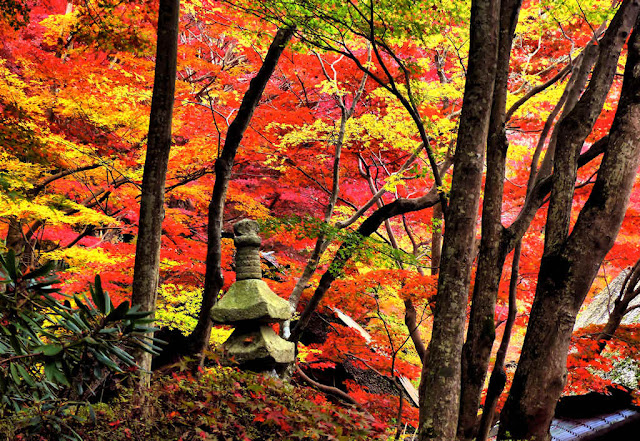Friday, November 8, 2024
Kyorinbo in Autumn Splendour
Thursday, November 28, 2019
2019 Fall Colors Walk Day 2 Saba Kaido
2019 Fall Colors
On the second day I headed up the Saba Kaido, the old road that ran from Obama on the coast down through the mountains to Kyoto. I started in Ohara and first visited Sanzen-in Temple, and for me, this was my first visit.
The temple is known for it's extensive gardens and grounds, and as the sun peeked over the mountains they were truly delightful and at 8:30 in the morning not yet crowded.
Next I made a visit to Hosen-in, one of the smaller temples nearby. This had a garden to be enjoyed while sitting inside drinking tea, but also an unusual, smaller one that was walked through. This one I found more intriguing. There was more to see in Ohara but I had a long way to go so headed north....
After climbing steadily for several hours, by early afternoon I had crossed the pass and started heading downhill into Shiga. On this side of the pass the autumn colors seemed a little more further along than in Kyoto....
By late afternoon I reached Myou-in Temple in Katsurgawa, one of the Kinki Fudo Myo Pilgrimage temples and my reason for this walk.
Monday, December 5, 2016
Hunting the Fall Color 2016 Day 7
Across from where Nobunagas Azuchi Castle once stood I climbed the mountain on my way to Kannonji, the penultimate temple of the pilgrimage. Halfway up the mountain was Kuwanomidera, a little known but ancient temple that was a real deight not only for its fall colors but also for the statuary.
On top of the mountain was the ruins of a small castle from the warring-states period, then a short way down the other side Kanninji itself, where the Buddha himself was enjoying the Fall colors.
Jizo seemed also to be enjoying it.
The real surprise of the day, and perhaps the whole trip, was Kyorinbo, a small sub-temple located below Kannonji. In terms of Autumn display it rivals anything Kyoto has to offer. The thatched roof covered in maple leaves was particularly stunning.
I was disappointed that I would not be able to make it here for the night time illumination, but the final temple of the pilgrimage beckoned and so I headed off in the sunshine north along the Nakasendo.
Monday, June 6, 2011
Hiyoshi Taisha part 2
The first shrine building to be built here was probably built around the latter part of the seventh Century. For a brief period the “ emperor” known as Tenji moved his court from the Yamato Plain to Otsu a few miles south of Hie, and he brought with him and enshrined in what is now the western compound of Hiyoshi Taisha the kami of Miwa, Onamuchi, the Yamato aspect of Okuninushi. So both of the first kami enshrined here trace their roots to Izumo.
The Mikoshi of Hie are quite famous, and a special storeroom/museum exists to display examples of older ones. Enryaku-ji had become a powerful economic and political force by the 12th Century, and the monks used the mikoshi to “attack” Kyoto to coerce the government to accede to demands. The mikoshi were taken up and over Hiezan and the monks marched on Kyoto and left the mikoshi at various points around the city. Kami were feared as well as revered, and fear of the anger of the kami in the mikoshi put pressure on the government.
Under the control of the Tendai monastery Enryaku-ji there developed the cult of Sanno at Hie. Known as the Mountain King, developed from the center of Tendai in China, the messenger of Sanno is the monkey.
In all a total of 108 upper and 108 lower shrines were constructed here. 108 is a significant number in Buddhism. many of the shrines have long gone, but many remain. Some of the shrines are Usa, enshrining hachiman, Shirayama, enshrining Izanagi and Izanami, Otoshi, the father of Oyamakui, the shrines main kami , and a Suga, enshrining Susano, Oyamakuis grandfather.
The frounds of Hiyoshi are very large and many visitors come for the Fall foliage. There is even a restaurant and tea room within the forest.
Hiyoshi has a unique torii. Often referred to as symbolizing the mountain, the triangle actually symbolizes the unity of buddhas and kami. It was removed in 1869 with shinbutsubunri, but reinstated after WWII.
Wednesday, June 1, 2011
Hiyoshi Taisha
Hiyoshi Taisha, also known as the Hie shrines, lie at the foot of eastern slopes of Mount Hie, in Sakamoto , Shiga Prefecture.
It is a large complex of shrines, though not as large as it was. At the height of its power there were 108 shrines within its grounds.
Like many shrines the identity of the kami enshrined have undergone may changes over the years.
The shrine grew to prominence as the tutelary shrines of the Tendai monastery complex on top of Mt Hie, Enryaku-ji. Like Enryaku-ji, the Hie shrines were razed to the ground by Oda Nobunaga in 1571, so none of the building date back earlier than that.
The area around Hiezan and Lake Biwa was settled by immigrant clans from the Korean peninsular, and the very first “shrine” here was worshipped by them, although no buildings buildings yet existed. Near the top of Mt. Hachioji, a foothill of Mt Hie, stands a hug rock with a flat surface. Known as the Golden Rock as it reflects the morning sun, this was probably the first shrine, and the kami was Oyamakui, a harvest deity, a son of Otoshi, one of Susano's many sons. Many of Otoshi's other “children” were kami also worshipped by immigrant clans.
Two shrine buildings now flank the Golden Rock, and a long, wide, staircase goes up there from the lower shrines.


















































